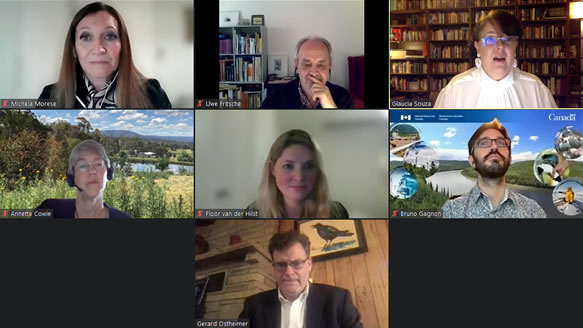Growing demands for food, feed, fibres and fuels together with prospects for a shift away from fossil fuels set the frame for potentially fierce competition for limited land and biomass resources.
This session provided up-to-date information about climate and sustainability effects of bioenergy systems as well as governance addressing opportunities and challenges in developing new biobased solutions that contribute to climate change mitigation and adaptation along with also other sustainable development goals.
Moderator
Glaucia Mendes Souza, Full Professor at the Institute of Chemistry, President of the FAPESP Bioenergy Research Program, University of São Paulo, Brazil
Presentations
Contribution of bioenergy systems to sustainable development goals ![]()
Bruno Gagnon, Senior Science and Policy Analyst in the Canadian Forest Service, Natural Resources Canada, Canada
Land use for bioenergy: synergies and trade-offs ![]()
Floor van der Hilst, Associate Professor at the Copernicus Institute of Sustainable Development, Utrecht University, The Netherlands
How sustainable forest bioenergy contributes to climate goals ![]()
Annette Cowie, Senior Principal Research Scientist Climate, NSW Department of Primary Industries | Agriculture, Australia
New Biofuture Platform workstream on sustainability governance and biomass quantification ![]()
Gerard Ostheimer, Founder & CEO, Biofuture Workshop, United States
Governing sustainable bioenergy pathways towards climate goals ![]()
![]()
Michela Morese, Executive Secretary, Global Bioenergy Partnership (GBEP), Italy
Uwe Fritsche, Scientific Director, IINAS, Germany

Highlights of the session
- Bioenergy should not be considered in isolation, but as part of a broader bioeconomy. It is by definition cross-cutting and requires a holistic approach over different policy fields. The risk is that this is perceived as complex by policy makers. Sustainability governance is a key requirement – it is critical that there is a thorough and transparent monitoring of evolutions in the field of the bioeconomy and its impacts to assist policy making.
- It is important to consider bioenergy/bioeconomy in relation to the Sustainable Development Goals (SDGs). Bioenergy touches on several SDGs, not only SDG7 (energy) of SDG13 (climate). For almost all SDGs both synergies and trade-offs can occur. Depending on the contextual conditions, it can turn out to be a synergy or a trade-off.
- Good practices show multiple co-benefits, going beyond energy and climate alone, e.g., in terms of soil quality and land restoration as well as rural development, while limiting potential negative effects. Most positive impacts are reached if biomass production systems are integrated into land and resource management systems in a way that complements, not competes with existing production systems and involve close cooperation and partnerships amongst multiple stakeholders along the supply chain.
- Land use can be a critical issue, particularly if large blocks of land would be devoted to energy crops (as could be required if extreme amounts of carbon dioxide removal would be needed to compensate for delays in climate action). Nevertheless, there are many good examples of biomass production, e.g., on abandoned/marginal lands, through integrated production with food/feed crops (as intercrop, in riparian areas, as wind buffer, …), or through the use of agricultural residues.
- There is high debate on the climate impacts of using forest biomass for energy, with studies providing conflicting results. What is often insufficiently recognised is that (commercial) forests are primarily managed for timber, with biomass being a co-product. There can be important analytical difference in studies/reports, e.g., in terms of system boundaries (short vs medium timeframe; stand vs landscape level; bioenergy only vs different products coming from the forest) and the assumed counterfactual (in terms of land use and energy system). Only considering the smokestack or just considering the forest carbon ignores important parts of the system; we need to look at the broader picture (including the forest carbon storage and sink, the forest products, the bioenergy produced) to understand the climate impact of how the forest is managed.
- There are many uncertainties in terms of global/regional sustainable biomass availability, going from very cautious estimates to analyses taking into account extra mobilisation efforts, coming to a wide range of figures from less than 30 EJ to more than 100 EJ at the global level. This uncertainty also has a knock-on effect on the demand side. To derisk feedstock availability for investors, the CEM Biofuture Platform Initiative starts a new workstream on sustainability governance and biomass quantification for which it will engage different experts and stakeholders. IEA Bioenergy and GBEP will contribute to that.

Recording


